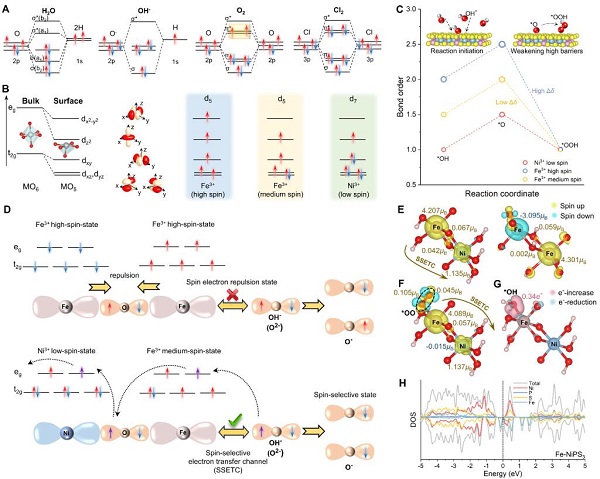XJTU achieves breakthrough in electrocatalytic water oxidation mechanism

Researchers from XJTU propose a novel mechanism for atomic-level localized spin regulation through an asymmetric Fe-Ni tacticity strategy.
Water electrolysis technology, a key pathway for producing green hydrogen energy, is constrained by the sluggish kinetics of the anodic oxygen evolution reaction (OER). Research indicates that the spin-state transition from singlet H₂O/OH⁻ to triplet O₂ during OER constitutes an intrinsic reaction barrier.
However, effective methods for regulating the spin state of OER catalysts remain scarce. Although external magnetic field enhancement has been attempted, it requires additional energy input, and its enhancement mechanism remains controversial, highlighting the urgent need for new strategies to achieve spin regulation without external fields.
Researchers from Xi'an Jiaotong University (XJTU) have proposed a novel mechanism for atomic-level localized spin regulation through an asymmetric Fe-Ni tacticity strategy. Introducing Fe into the NiPS₃ lattice induces spin-state redistribution, forming Fe³⁺ active sites with a medium-spin (MS) state. The MS state of Fe³⁺ is further stabilized through P/S coordination, while self-sacrificial suppression inhibits competitive Cl⁻ oxidation reactions and Cl⁻ poisoning.
This catalyst exhibits outstanding performance in both alkaline and real seawater electrolysis, achieving operating voltages of only 1.50 V and 1.52 V at 10 mA cm⁻² and maintaining stable operation for over 1,000 hours. It also demonstrates stable low-voltage operation advantages in anion exchange membrane (sea) water electrolyzer (AEM(S)WE) devices.
The critical role of MS Fe³⁺ in promoting spin-selective electron transfer was systematically elucidated through multidimensional techniques, including theoretical calculations, X-ray absorption spectroscopy, electron paramagnetic resonance, and Mössbauer spectroscopy.
This study provides a new paradigm for constructing intrinsic spin-regulation pathways in non-precious metal catalytic systems, offering significant insights for designing green and efficient hydrogen production catalysts.
This research was published in Science Advances under the title Asymmetric tacticity navigates the localized metal spin state for sustainable alkaline/sea water oxidation.

